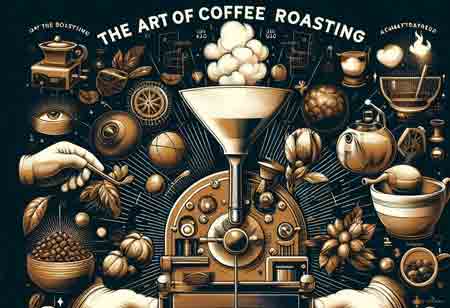Thank you for Subscribing to Food Business Review Weekly Brief
- Home
- Topics
- Alternative Proteins and Plant Based Food
- Beer and Wine
- Canned Beverages
- Coffee And Tea
- Food and Beverage Consulting
- Food and Beverage Financial Service
- Food And Beverages Marketing
- Food Distributors
- Food Ingredients
- Food Sustainability
- Plant Based Food and Beverages
- Seafood Suppliers
- Supplement Manufacturing
- Wine Investment
- News
- Vendor Viewpoint
- CXO Insights
- Conferences
- Newsletter
- CXO Awards
-
The Art of Coffee Roasting: Methods Explored
Two widely recognized methods for roasting coffee are drum Roasting and Hot Air Roasting. The selection among these methods frequently depends on the preferred flavor profile, the scale of production, and the energy considerations of the roaster.

By
Food Business Review | Thursday, March 06, 2025
Stay ahead of the industry with exclusive feature stories on the top companies, expert insights and the latest news delivered straight to your inbox. Subscribe today.

Fremont, CA: The process of roasting coffee is intricate. When green coffee beans are exposed to roasting, numerous transformations occur. Initially, the beans transition from a pale yellow to a rich brown as the Maillard Reaction commences. This reaction involves the interaction of reducing sugars and amino acids, resulting in the development of aroma and flavor, effectively converting a tasteless, hard seed into a beloved morning staple.
The duration of roasting and the development phase of coffee significantly influence the flavor profile of the final brew. A shorter development phase following the first crack yields a brighter and more acidic cup, characterized by pronounced citrus, floral, and herbal notes typical of a light roast.
As the roasting process continues beyond this stage, the sugars within the coffee begin to caramelize, which enhances the overall sweetness. Further development leads to a darker roast, which increases the body of the coffee while diminishing its acidity and sweetness. If the roasting is extended, a second crack will occur, resulting in a brew dominated by oily, roasted flavors.
Different Methods for Roasting Coffee
Two primary methods are employed in the roasting process of this coffee: the conventional Drum Roasting technique and the Hot Air Roasting method.
Drum Roasting
Drum roasting is one of the oldest and most traditional methods used in the coffee industry. This process involves placing green coffee beans into a large rotating drum, either externally or internally. As the drum rotates, the beans tumble inside, allowing them to be evenly exposed to the heat. This consistent motion ensures that the beans are roasted uniformly, crucial for developing a balanced flavor profile. Drum roasting allows roasters to finely control the temperature and duration of the roast, allowing them to tailor the process to highlight specific characteristics of the coffee beans. However, this method can be energy-intensive, and additional equipment is required to cool the beans quickly after roasting to halt the process immediately.
Hot Air Roasting
Hot air or fluid bed roasting utilizes hot air to roast the coffee beans. The beans are suspended and moved around by the hot air, ensuring even roasting from all sides. This method is generally faster than drum roasting and can result in a cleaner and brighter flavor profile, as it reduces the risk of scorching the beans. Moreover, hot air roasting tends to be more energy-efficient. However, one of the limitations of this method is its capacity; hot air roasters typically handle smaller batches than drum roasters. Some coffee enthusiasts argue that hot air roasting may not develop as complex a flavor profile as drum roasting, especially for darker roasts.






